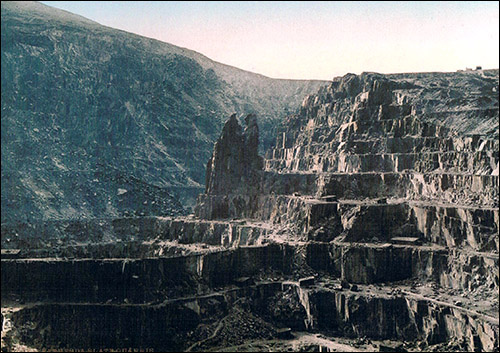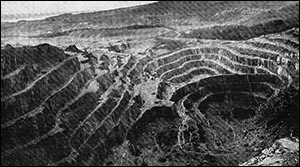Penrhyn slate quarry

Having begun operation in the 18th century, Penrhyn became the world’s largest slate quarry in the 19th, when it employed more than 2,500 people. Bethesda town grew rapidly, and in 1864 there were complaints that the population of 8,000 had just two resident policemen to maintain order!
Visitors, including Princess Victoria, came to gaze at the quarry and “Talcen Mawr”, a volcanic intrusion rising 90 metres (300ft). It’s visible in the centre of the photo on the right. After becoming unsafe, Talcen Mawr was blasted away in 1895, watched by hundreds of spectators. A similar initiative, watched by Lord Penrhyn, at Dinorwig slate quarry in 1896 was an embarrassing flop.
In 1903, during the bitter three-year Penrhyn quarry strike, David Lloyd George (the future Prime Minister) told a meeting of 2,000 Liberals in Newcastle-upon-Tyne that the quarry was dug from common land which had fallen into the hands of a rich slave-owner in the early 19th century. The quarry had largely been run on slave-driving principles ever since, he argued. Lord Penrhyn’s inherited fortune stemmed from Jamaican sugar production using hundreds of slaves. The family sold its Jamaican estates in the 1930s.
Quarrying was hard and dangerous. Workers here were often injured, killed or developed lung disease from inhaling dust. In 1861 a falling five-ton boulder killed a worker, severing his arm. His heart was found 4.6 metres from his body, and his blood descended “like rain upon the terrace of rock below”.
 Richard Hughes died in 1882 while working on one of the inclines. Entangled in the haulage cable, he was drawn up into the winding drum.
Richard Hughes died in 1882 while working on one of the inclines. Entangled in the haulage cable, he was drawn up into the winding drum.
There were several industrial disputes here in the 19th century, and in 1874 the North Wales Quarrymen’s Union was formed. It was the quarrymen’s greatest victory but Lord Penrhyn wanted to eliminate the union’s influence in his quarry. He abolished the “bargain” system, where quarrymen negotiated monthly earnings based on the quality of rock they were working (enabling them to consider themselves as contractors rather than employees).
The quarrymen thought his actions signalled a lack of respect and appreciation of their considerable skills. There were other grievances too, and in November 1900 the men walked out. Lord Penrhyn was intransigent, and the three-year strike was one of the longest in British history. Hundreds of people left Bethesda for good. Some who remained nearly starved to death, and businesses failed amid lack of custom. The rancour between strikers and those who returned to work led to violence, arrests and suicide.
The quarry still produces slate. The Zip World attraction opened in 2013, with zipwires across the disused quarry pit.
With thanks to Dr Hazel Pierce, of The History House
Sources include; Jones, CS, What I Saw at Bethesda, with intro by J Elwyn Hughes (Ceredigion, 2003); Jones, RM, The North Wales Quarrymen 1874-1922 (Cardiff, 1981); Gwyn, D, Welsh Slate Archaeology and History of an Industry (RCAHMW, Aberystwyth).

